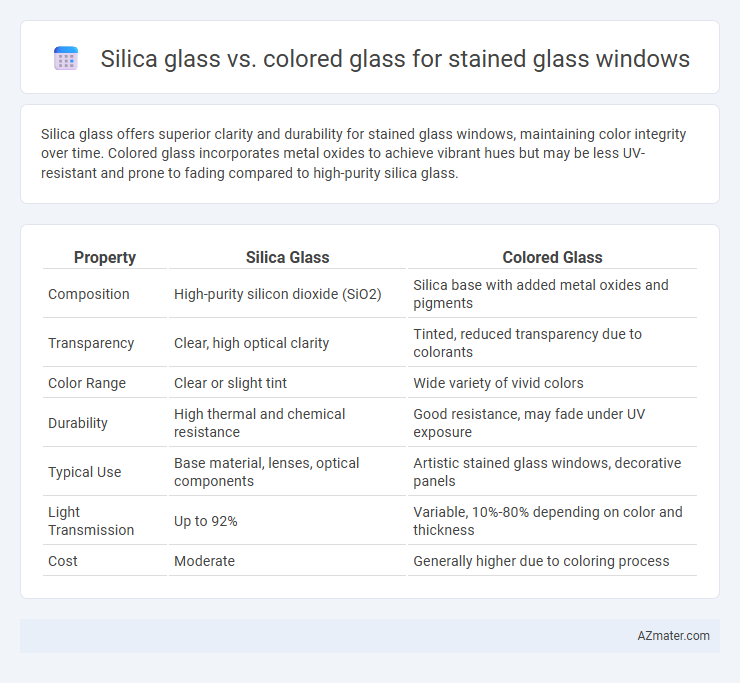Silica glass offers superior clarity and durability for stained glass windows, maintaining color integrity over time. Colored glass incorporates metal oxides to achieve vibrant hues but may be less UV-resistant and prone to fading compared to high-purity silica glass.
Table of Comparison
| Property | Silica Glass | Colored Glass |
|---|---|---|
| Composition | High-purity silicon dioxide (SiO2) | Silica base with added metal oxides and pigments |
| Transparency | Clear, high optical clarity | Tinted, reduced transparency due to colorants |
| Color Range | Clear or slight tint | Wide variety of vivid colors |
| Durability | High thermal and chemical resistance | Good resistance, may fade under UV exposure |
| Typical Use | Base material, lenses, optical components | Artistic stained glass windows, decorative panels |
| Light Transmission | Up to 92% | Variable, 10%-80% depending on color and thickness |
| Cost | Moderate | Generally higher due to coloring process |
Composition Differences: Silica Glass vs Colored Glass
Silica glass primarily consists of high-purity silicon dioxide (SiO2), giving it a clear and transparent quality ideal for stained glass windows requiring brilliance and clarity. Colored glass incorporates metal oxides such as cobalt for blue, chromium for green, and gold for red, altering its chemical composition to produce vibrant hues. The difference in composition influences not only color but also thermal properties and durability, with silica glass offering higher resistance to heat and weathering compared to many colored glass variants.
Manufacturing Processes Explained
Silica glass used in stained glass windows is manufactured through a high-purity, high-temperature melting process, ensuring clarity and thermal stability, ideal for intricate designs and longevity. Colored glass involves adding metal oxides or sulfides during melting, such as cobalt for blue or gold for red hues, requiring precise temperature control to achieve vibrant, consistent coloration. Both types undergo controlled annealing to relieve internal stresses, but silica glass demands stricter purity standards to prevent inclusions that could affect transparency and durability in architectural applications.
Optical Properties and Light Transmission
Silica glass offers superior optical clarity and higher light transmission compared to colored glass, making it ideal for stained glass windows requiring vivid detail and brightness. Colored glass contains metal oxides that absorb specific wavelengths, resulting in reduced overall light transmittance but richer, more saturated colors. The choice between silica and colored glass significantly affects the balance of light diffusion, color vibrancy, and visual impact in stained glass installations.
Durability and Longevity Comparison
Silica glass, known for its high purity and thermal stability, offers superior durability and resistance to weathering compared to colored glass used in stained glass windows. Colored glass typically contains metal oxides that may degrade over time due to environmental exposure, leading to fading or surface damage. The enhanced chemical inertness and hardness of silica glass significantly extend the longevity of stained glass installations in both interior and exterior applications.
Color Consistency and Vibrancy
Silica glass offers superior color consistency due to its high purity and controlled composition, resulting in uniform vibrancy across stained glass windows. Colored glass, often made by adding metal oxides or other compounds, can display variations in hue and saturation, potentially affecting the overall visual harmony. For stained glass applications requiring precise and vibrant coloration, silica glass provides a more reliable and vivid solution.
Suitability for Intricate Designs
Silica glass offers superior clarity and uniformity, making it highly suitable for achieving intricate designs in stained glass windows due to its fine grain structure and consistent texture. Colored glass, often made with added metal oxides and impurities, provides vibrant hues but may exhibit variations in thickness and texture, which can challenge the precision required for detailed patterns. For artisans aiming to create delicate and complex motifs, silica glass allows for cleaner cuts and smoother edges, enhancing the overall detail and light transmission in stained glass artworks.
Cost Analysis: Silica vs Colored Glass
Silica glass typically costs more than colored glass due to its higher purity and specialized manufacturing process. Colored glass, often made by adding metal oxides to standard glass, offers a more affordable option for stained glass windows without compromising aesthetic variety. The choice between silica and colored glass depends on budget constraints and desired visual effects, with silica suited for premium, durable installations and colored glass preferred for cost-effective artistic projects.
Environmental Impact and Sustainability
Silica glass, primarily composed of pure silicon dioxide, offers superior recyclability and lower environmental toxicity compared to colored glass, which often contains metal oxides and additives that can complicate recycling processes. The production of silica glass typically demands less energy and emits fewer harmful substances, enhancing its sustainability profile for stained glass windows. Colored glass, while visually vibrant, may contribute to increased carbon emissions and resource depletion due to complex manufacturing and pigment sourcing.
Maintenance and Restoration Considerations
Silica glass offers superior durability and resistance to weathering, making it easier to maintain in stained glass windows as it is less prone to fading or chemical damage compared to colored glass. Colored glass, often composed of various metal oxides, can suffer from surface corrosion and color degradation over time, requiring specialized restoration techniques such as careful cleaning and re-painting to preserve its appearance. Restoration of silica glass generally involves minimal intervention, while colored glass demands more frequent inspection and meticulous repair to maintain its structural and aesthetic integrity.
Choosing the Right Glass for Your Stained Glass Windows
Silica glass offers superior clarity and durability, making it ideal for stained glass windows requiring long-lasting brilliance and minimal color distortion. Colored glass provides vibrant, rich hues essential for creating intricate designs and artistic effects in stained glass artistry. Selecting the right glass depends on the desired balance between visual impact, longevity, and the specific artistic goals of your stained glass window project.

Infographic: Silica glass vs Colored glass for Stained glass window
 azmater.com
azmater.com